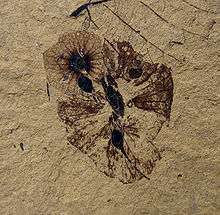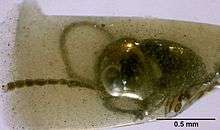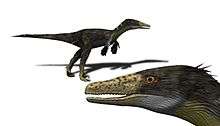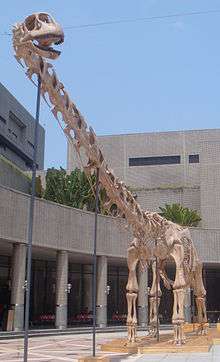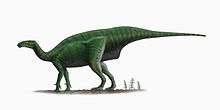2008 in paleontology
| |||
|---|---|---|---|
| Wikimedia Commons has media related to 2008 in paleontology. |

Paleontology or palaeontology (from Greek: paleo, "ancient"; ontos, "being"; and logos, "knowledge") is the study of prehistoric life forms on Earth through the examination of plant and animal fossils.[1] This includes the study of body fossils, tracks (ichnites), burrows, cast-off parts, fossilised feces (coprolites), palynomorphs and chemical residues. Because humans have encountered fossils for millennia, paleontology has a long history both before and after becoming formalized as a science. This article records significant discoveries and events related to paleontology that occurred or were published in the year 2008.
Plants
Angiosperms
| Name | Novelty | Status | Authors | Age | Unit | Location | Notes | Images |
|---|---|---|---|---|---|---|---|---|
|
Gen. et sp. nov. |
Valid |
Manchester & Pigg |
Unnamed Formation, Kamloops Group |
| ||||
|
Pluricarpellatia[3] |
Gen. et sp. nov. |
Valid |
Mohr, Bernardes-de-Oliveira & Taylor |
Crato Formation |
Monocots
| Name | Novelty | Status | Authors | Age | Unit | Location | Notes | Images |
|---|---|---|---|---|---|---|---|---|
|
sp nov |
Valid |
Herrera et al |
only fossil record of the genus Montrichardia |
|||||
|
gen et sp nov |
Valid |
Herrera et al |
Two named species Petrocardium cerrejonense and Petrocardium wayuuorum |
|||||
Protozoa
New taxa
| Name | Novelty | Status | Authors | Age | Unit | Location | Notes | Images |
|---|---|---|---|---|---|---|---|---|
|
sp nov |
Valid |
second record, and youngest, of the extinct genus Paleoleishmania |
||||||
Arthropoda
Insects
| Name | Novelty | Status | Authors | Age | Unit | Location | Notes | Images |
|---|---|---|---|---|---|---|---|---|
|
Gen et sp nov |
valid |
Azar & Nel |
A Megapodagrionidae damselfly |
|||||
|
gen et sp nov |
Vaild |
Li, Ren & Shih |
A bittacid |
|||||
|
gen et sp nov |
Vaild |
Perrichot et al |
Charentese amber |
A Sphecomyrminae ant, type species H. mammuthus |
| |||
|
gen et sp nov |
Valid |
Li, Ren & Shih |
A bittacid |
|||||
|
sp nov |
Valid |
Poinar |
Vector for the extinct Trypanosomatidae |
|||||
|
sp nov |
Valid |
Jarzembowski |
||||||
|
sp nov |
Valid |
Jarzembowski |
||||||
|
gen et sp nov |
Valid |
Ren, Nel, & Prokop |
Tupo Formation |
Third Namurian age Meganeuridae griffenfly described. |
||||
|
Sp nov |
jr syn |
Perrichot et al |
Middle Cretaceous |
Charentese amber |
A stem group ant |
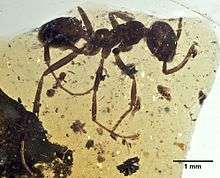 G. occidentalis holotype | ||
|
Sp nov |
Vaild |
Woodruff |
||||||
|
Sp nov |
Vaild |
Xiphosurans
| Name | Novelty | Status | Authors | Age | Unit | Location | Notes | Images |
|---|---|---|---|---|---|---|---|---|
|
gen et sp nov |
Valid taxon |
Nowlan, Rudkin, & Young |
||||||
Fishes
Cartilaginous fish
- Cicimurri D. J.; Parris D. C.; Everhart M. J. (2008). "Partial dentition of a chimaeroid fish (Chondrichthyes, Holocephali) from the Upper Cretaceous Niobrara Chalk of Kansas, USA". Journal of Vertebrate Paleontology. 28 (1): 34–40. doi:10.1671/0272-4634(2008)28[34:PDOACF]2.0.CO;2. ISSN 0272-4634.
Bony fish
| Name | Novelty | Status | Authors | Age | Unit | Location | Notes | Images |
|---|---|---|---|---|---|---|---|---|
|
Genyonemus whistleri[13] |
Valid |
|
Late Miocene |
A relative of the white croaker. |
||||
Placoderms
| Name | Novelty | Status | Authors | Age | Unit | Location | Notes | Images |
|---|---|---|---|---|---|---|---|---|
| Materpiscis[14] |
gen et sp nov |
Valid |
J. A. Long, K. Trinajstic, G. C. Young, & T. Senden |
discovered with fossilized embryo. |
.jpg) Materpiscis embryo features | |||
Amphibians
Jenkins, F. A., jr, Shubin, N. H., Gatesy, S. M., and Warren, A., 2008, Gerrothorax pulcherrimus from the Upper Triassic Fleming Fjord Formation of East Greenland and a reassessment of head lifting in temnospondyl feeding: Journal of Vertebrate Paleontology, v. 28, n. 4, p. 935-950.
Newly named amphibians
| Name | Status | Authors | Age | Unit | Location | Notes | Images |
|---|---|---|---|---|---|---|---|
| Beelzebufo[15] | Valid taxon | Late Cretaceous (70 mya) | Maevarano Formation | |
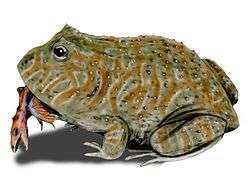 An artist's depiction of Beelzebufo | ||
| Gerobatrachus[16] | Valid taxon |
|
Early Permian (290 mya) | |
|||
| Oumtkoutia[17] | Valid taxon |
|
Late Cretaceous (Cenomanian) | Kem Kem Beds | |
A pipid anuran. | |
Ornithodirans
Newly named pterosaurs
|
||||||||||||||||||||||||||||||||||||||||||||||||||
Dinosaurs
- Oviraptorosaurian eggs with embryonic skeletons are discovered for the first time in China.[18]
- Mongolian Late Jurassic theropod fossils are found for the first time.[19]
- A new study on morphological variation in shed theropod teeth from the Mil River Formation is published.[20]
Newly named dinosaurs
28 new dinosaur genera were erected in 2008. Data courtesy of George Olshevky's dinosaur genera list.[21]
| Name | Status | Authors | Age | Unit | Location | Notes | Images |
|---|---|---|---|---|---|---|---|
|
Valid |
|
Campanian–Maastrichtian |
The largest dromaeosaurid yet discovered in the Southern Hemisphere. |
| |||
|
Valid |
Barremian |
A new genus for "Iguanodon" lakotaensis (Weishampel and Bjork, 1989). | |||||
|
Valid |
|
Lower Cretaceous |
Lanzhou Basin |
A basal titanosaur. | |||
|
Junior synonym |
Late Cretaceous |
Objective junior synonym of Nedoceratops; possible junior synonym of Triceratops. | |||||
|
Valid |
|
Barremian |
An iguanodontian. | ||||
|
Valid |
|
early Late Cretaceous |
Fangyang Formation |
||||
|
Valid |
|
Bajocian |
A megalosaurid. | ||||
|
Valid |
Aptian/Albian |
||||||
|
Valid |
|
Middle Jurassic |
Zhanghe Formation |
||||
|
Valid |
|
Late Jurassic |
An avialian. | ||||
|
Valid |
|
Late Cretaceous |
Possible junior synonym of Bagaceratops. | ||||
|
Valid |
|
Aptian/Albian |
An abelisaurid. | ||||
|
Valid |
Callovian |
A stegosaurid. | |||||
|
Campanian |
||||||
|
Valid |
|
Maastrichtian |
A neovenatorid. | ||||
|
Valid |
|
Lower Cretaceous |
A nodosaurid ankylosaur. | ||||
|
Valid |
|
Campanian |
A titanosaur. | ||||
|
Valid |
|
Late Cretaceous |
A titanosaur. | ||||
|
Valid |
|
Maastrichtian |
A lambeosaurine hadrosaurid. | ||||
|
Valid |
|
Aptian |
A caudipterid oviraptorosaur. | ||||
|
Valid |
|
Aptian |
A titanosauriform. | ||||
|
Valid |
|
Upper Cretaceous |
A titanosaur. | ||||
|
Valid |
|
Maastrichtian |
A saurolophine hadrosaurid. | ||||
Newly named birds
| Name | Novelty | Status | Authors | Age | Unit | Location | Notes | Images |
|---|---|---|---|---|---|---|---|---|
|
Aegolius martae [41] |
Sp. nov. |
Valid |
Marco Pavia |
Early/Middle Pleistocene |
A Strigidae. |
|||
|
Gen. nov. et Sp. nov. |
Valid |
Late Pleistocene |
An Accipitridae, this is the type species of the new genus. |
|||||
|
Gen. nov. et Sp. nov. |
Valid |
Graham M. Wragg |
Subrecent |
A Columbidae, this is the type species of the new genus. |
||||
|
Calonectris wingatei [44] |
Sp. nov. |
Valid |
Middle Pleistocene |
|||||
|
Sp. nov. |
Valid |
A Falconidae. |
||||||
|
Sp. nov. |
Valid |
Li Jianjun Li Zhiheng Zhang Yuguang Bai Zhiqiang Zhang Lifu Ba Tuya |
Early Cretaceous |
Jinchuan Formation |
A Cathayornithidae Zhou, Jin et Zhang, 2006, Enantiornithes Walker, 1981. |
|||
|
Certhiops rummeli [47] |
Gen. nov. et Sp. nov. |
Valid |
Albrecht Manegold |
Early Miocene |
A Certhioidea, this is the type species of the new genus. |
|||
|
Didactylornis jii [48] |
Gen. nov. et Sp. nov. |
Valid |
Yuan Chongxi |
Lower Cretaceous |
Basal pygostylia, Sapeornithidae, this is the type species of the new genus. |
|||
|
Gen. nov. et Sp. nov. |
Valid |
Andrea Cau Paolo Arduini |
Upper Cretaceous |
An Enantiornithes Walker, 1981, Avisauridae Brett-Surman et Paul, 1985, this is the type species of the new genus. |
||||
|
Gen. nov. et Sp. nov. |
Valid |
Fucheng Zhang Zhonghe Zhou |
A Primitive Confuciusornithidae Hou, Zhou, Gu et Zhang, 1995, this is the type species of the new genus. |
|||||
|
Ephippiorhynchus tchoufour [51] |
Sp. nov. |
Valid |
Antoine Louchart Patrick Vignaud Androssa Likius |
Late Miocene |
ca 7 Ma |
A Ciconiidae. |
||
|
Eurotrochilus noniewiczi [52] |
Sp. nov. |
Valid |
Zygmunt Bochenski Zbigniew Bochenski |
Early Oligocene |
Late Rupelian |
A new European species of the Trochilidae. |
||
|
Sp. nov. |
Valid |
Anthony S. Cheke |
Subrecent |
Not seen since 1672 |
The original Foudia from Réunion. |
|||
|
Hokkaidornis abashiriensis [54] |
Gen. nov. et Sp. nov. |
Valid |
Kazuhiko Sakurai Masaichi Kimura Takayuki Katoh |
Late Oligocene |
Tokoro Formation |
A Plotopteridae Howard, 1969, this is the type species of the new genus. |
||
|
Jabiru codorensis [55] |
Sp. nov. |
Valid |
Stig A. Walsh |
Early Pliocene |
Codore Formation, Middle El Jebe Member |
A Ciconiidae. |
||
|
Sp. nov. |
Valid |
Jorge I. Noriega Gerardo Cladera |
Late Miocene |
Puerto Madryn Formation |
A Ciconiidae. |
|||
|
Sp. nov. |
Valid |
Alan J. D. Tennyson Suzanne J. Hand R. Paul Scofield |
Early-Middle Miocene |
Bannockburn Formation |
An Anatidae, Anserinae. |
|||
|
Sp. nov. |
Valid |
Sanne Boessenkool Jeremy J. Austin R. Paul Scofield Philip J. Seddon Jonathan M. Waters |
Late Holocene |
Subrecent |
A Spheniscidae, when it became extinct it made room for Megadyptes antipodes. |
|||
|
Gen. nov. et Sp. nov. |
Valid |
David W. Waterhouse Bent E. K, Lindow Nikita V. Zelenkov |
Early Eocene, |
Described in the Psittaciformes, Gerald Mayr, 2009 sees no reasons to place the species in Psittaciformes. |
||||
|
Palaeortyx volans [60] |
Sp. nov. |
Valid |
Ursula B. Göhlich Marco Pavia |
A Phasianidae. |
||||
|
Pelagornis mauretanicus [61] |
Sp. nov. |
Valid |
Cécille Mourer-Chauviré Denis Geraads |
Late Pliocene |
A Pelagornithidae Fürbringer, 1888. |
|||
|
Gen. nov. et Sp. nov. |
Valid |
Julia A. Clarke Zhang Fucheng |
An Enantiornithes Walker, 1981, this is the type species of the new genus and the type genus of the new family Pengornithidae Wang, O’Connor, Zheng, Wang, Hu et Zhou, 2014. |
|||||
|
Phaethusavis pelagicus [63] |
Gen. nov. et Sp. nov. |
Valid |
Estelle Bourdon Mbarek Amaghzaz Baâdi Bouya |
Early Eocene |
Early Ypresian |
A Phaethontidae, this is the type species of the new genus. |
||
|
Pleistovultur nevesi [64] |
Gen. nov. et Sp. nov. |
Valid |
Herculano M. F. de Alvarenga Guilherme R. R. Brito Rafael Migotto Alex Hubbe Elizabeth Höfling |
Late Pleistocene-Early Holocene |
A Cathartidae, this is the type species of the new genus. |
|||
|
Thomasococcyx philohippus [65] |
Gen. nov. et Sp. nov. |
Valid |
Early Miocene |
Hemingfordian LMA |
|
A Cuculidae, this is the type species of the new genus. |
||
|
Tirarinetta kanunka [66] |
Gen. nov. et Sp. nov. |
Valid |
Tirari Formation |
An Anatidae, this is the type species of the new genus. |
||||
|
Gen. nov. et Sp. nov. |
Valid |
Gao Chunling Meng Qinjing Jingmai O'Connor Wang Xuri Cheng Xiaodong Liu Jinyuan |
Basal Aves, this is the type species of the new genus. |
|||||
|
Zygodactylus luberonensis [68] |
Sp. nov. |
Valid |
Early Oligocene |
MP 23-24 |
A Zygodactylidae Brodkorb, 1971, ?Piciformes. |
|||
Other publications
- Hutchinson, J.R., Miller, C., Fritsch, G., and Hildebrandt, T. 2008. The anatomical foundation for multidisciplinary studies of animal limb function: examples from dinosaur and elephant limb imaging studies; pp. 23–38 in Endo, H. and Frey, R. (eds.), Anatomical Imaging: Towards a New Morphology. Springer Verlag, Tokyo.
- Witmer, L.M., Ridgely, R.C., Dufeau, D.L., and Semones, M.C. 2008. Using CR to peer into the past: 3D visualization of the brain and ear regions of birds, crocodiles, and nonavian dinosaurs; pp. 67–88 in Endo, H. and Frey, R. (eds.), Anatomical Imaging: Towards a New Morphology. Springer Verlag, Tokyo.
Turtles
Newly named turtles
| Currently valid anapsid genera named in 2008 | ||||
|---|---|---|---|---|
| Name | Status | Location | Authors | Images |
| Odontochelys[69] | Valid taxon |
|
||
| Condorchelys[70] | Valid taxon |
| ||
Squamates
new taxa
| Name | Novelty | Status | Authors | Age | Unit | Location | Notes | Images |
|---|---|---|---|---|---|---|---|---|
|
Itaboraiophis[71] |
gen et sp nov |
Valid |
Rage |
Middle Paleocene |
A "booid"-grade snake of uncertain phylogenetic placement. The type species is Itaboraiophis depressus. |
|||
|
gen et sp nov |
Valid |
Evans & Manabe |
Early Cretaceous (Valanginian to Hauterivian) |
A polyglyphanodontian lizard. The type species is Kuwajimalla kagaensis. |
||||
|
Merkurosaurus[73] |
gen et sp nov |
Valid |
Klembara |
Early Miocene |
A member of Anguimorpha, might be related to the Chinese crocodile lizard. The type species is Merkurosaurus ornatus. |
|||
|
gen et sp nov |
Valid |
Norell, Gao, & Conrad |
near Ukhaa Tolgod |
one of the oldest monitor lizards |
||||
|
Paraungaliophis[71] |
gen et sp nov |
Valid |
Rage |
Middle Paleocene |
A snake related to members of the genus Ungaliophis. The type species is Paraungaliophis pricei. |
|||
|
Paulacoutophis[71] |
gen et sp nov |
Valid |
Rage |
Middle Paleocene |
A booid-grade snake of uncertain phylogenetic placement. The type species is Paulacoutophis perplexus. |
|||
|
sp nov |
Valid |
Caldwell, Konishi, Obata, & Muramoto |
Third identified species for the genus Taniwhasaurus |
|||||
|
Tianyusaurus[76] |
gen et sp nov |
Valid |
Lü et al. |
A polyglyphanodontian lizard. The type species is Tianyusaurus zhengi. |
||||
|
Tinosaurus indicus[77] |
Sp nov |
Valid |
Prasad & Bajpai |
Early Eocene |
Cambay Shale |
An agamid lizard, a species of Tinosaurus. |
||
|
gen et sp nov |
Valid |
Smith & Buchy |
Late Cretaceous (early Turonian) |
A member of Mosasauroidea of uncertain phylogenetic placement. The type species is Vallecillosaurus donrobertoi. |
||||
|
Vastanagama[77] |
Gen. et sp. nov |
Valid |
Prasad & Bajpai |
Early Eocene |
Cambay Shale |
An agamid lizard. The type species is Vastanagama susani. |
||
New papers
- Everhart, M.J. (2008). "A bitten skull of Tylosaurus kansasensis (Squamata: Mosasauridae) and a review of mosasaur-on-mosasaur pathology in the fossil record". Transactions of the Kansas Academy of Science. 111 (3/4): 251–262. doi:10.1660/0022-8443-111.3.251.
- Everhart, M.J. 2008. The mosasaurs of George F. Sternberg, paleontologist and fossil photographer. Proceedings of the Second Mosasaur Meeting, Fort Hays Studies Special Issue 3, Fort Hays State University, Hays, Kansas, pp. 37–46.
- Polcyn, M.J. and Everhart, M.J. 2008. Description and phylogenetic analysis of a new species of Selmasaurus (Mosasauridae: Plioplatecarpinae) from the Niobrara Chalk of western Kansas. Proceedings of the Second Mosasaur Meeting, Fort Hays Studies Special Issue 3, Fort Hays State University, Hays, Kansas, pp. 13–28.
- Polcyn, M.J., Bell, G.L., Jr., Shimada, K. and Everhart, M.J. 2008. The oldest North American mosasaurs (Squamata: Mosasauridae) from the Turonian (Upper Cretaceous) of Kansas and Texas with comments on the radiation of major mosasaur clades. Proceedings of the Second Mosasaur Meeting, Fort Hays Studies Special Issue 3, Fort Hays State University, Hays, Kansas, pp. 137–155.
- Everhart, M.J. 2008. Rare occurrence of a Globidens sp. (Reptilia; Mosasauridae) dentary in the Sharon Springs Member of the Pierre Shale (Middle Campanian) of Western Kansas. p. 23-29 in Farley G. H. and Choate, J.R. (eds.), Unlocking the Unknown; Papers Honoring Dr. Richard Zakrzewski, Fort Hays Studies, Special Issue No. 2, 153 p., Fort Hays State University, Hays, KS.
Plesiosaurs
New taxa
|
| ||||||||||||||||||
Synapsids
Non-mammalian
| Name | Status | Authors | Age | Unit | Location | Notes | Images |
|---|---|---|---|---|---|---|---|
|
Valid |
|
Middle Permian |
A new genus for "Biarmosuchus" tagax |
||||
|
Valid |
|
Upper Permian |
|||||
Mammal
| Newly named mammals | |||||||
|---|---|---|---|---|---|---|---|
| Name | Status | Authors | Age | Unit | Location | Notes | Images |
|
Albireo savagei[81] |
Valid |
|
Late Pliocene |
A member of Delphinoidea belonging to the family Albireonidae, a species of Albireo. | |||
|
Valid |
|
Eocene |
A member of Protocetidae. The type species is Crenatocetus rayi. | ||||
|
Cynarctoides whistleri[83] |
Valid |
|
A member of Canidae belonging to the subfamily Borophaginae, a species of Cynarctoides. | ||||
|
Valid |
|
Cabbage Patch beds |
|||||
|
Floridameryx[85] |
Valid |
|
Late Miocene to earliest Pliocene |
A member of Gelocidae belonging to the subfamily Pseudoceratinae. The type species is F. floridanus; genus also includes "Pseudoceras" klausi Frick (1937). | |||
|
Fossendorhinus[86] |
Valid |
|
A member of Brontotheriidae; a new genus for "Telmatherium" diploconus Osborn (1895) | ||||
|
Fredszalaya[87] |
Valid |
|
Late Oligocene |
A member of Borhyaenidae. The type species is Fredszalaya hunteri. | |||
|
Glibia namibiesis[88] |
Valid |
|
Eocene (Lutetian) |
A rodent belonging to the family Zegdoumyidae, a species of Glibia. | |||
|
Goleroconus[89] |
Valid |
|
A member of Periptychidae. The type species is Goleroconus alfi. | ||||
|
Korthomys[90] |
Valid |
|
A rodent belonging to the family Heteromyidae. A new genus for "Mookomys" formicarum Wood (1935). | ||||
|
Valid |
|
Late Miocene |
|||||
|
Valid |
|
Late Clarendonian to early Hemphillian |
Ash Hollow Formation |
A fox. The type species is Metalopex merriami. | |||
|
Mioheteromys crowderensis[90] |
Valid |
|
Late Hemingfordian to Barstovian |
A rodent belonging to the family Heteromyidae, a species of Mioheteromys. | |||
|
Moissenetia ziegleri[93] |
Valid |
Berger |
Oligocene |
A dormouse. | |||
|
Namahyrax[88] |
Valid |
|
Eocene (Lutetian) |
A hyrax. The type species is Namahyrax corvus. | |||
|
Namaia[88] |
Valid |
|
Eocene (Lutetian) |
An early simian. The type species is Namaia bogenfelsi. The generic name turned out to be preoccupied; Pickford and Uhen (2014) created a replacement name Notnamaia.[94] | |||
|
Namalestes[88] |
Valid |
|
Eocene (Lutetian) |
A member of Cimolesta belonging to the family Todralestidae. The type species is Namalestes gheerbranti. | |||
|
Namatherium[88] |
Valid |
|
Eocene (Lutetian) |
An embrithopod. The type species is Namatherium blackcrowense. | |||
|
Nasamplus[86] |
Valid |
|
Late Eocene (Ulangochuian) |
A member of Brontotheriidae; a new genus for "Metatitan" progressus Granger and Gregory (1943). | |||
|
Paratrogomys[90] |
Valid |
|
Lower Crowder Formation |
A rodent belonging to the family Heteromyidae. The type species is Paratrogomys whistleri. | |||
|
Pollyosbornia[86] |
Valid |
|
A member of Brontotheriidae; a new genus for "Telmatherium" altidens Osborn (1908). | ||||
|
Prepomonomys[88] |
Valid |
|
Eocene (Lutetian) |
A rodent belonging to the family Diamantomyidae. The type species is Prepomonomys bogenfelsi. | |||
|
Proadinotherium saltoni[87] |
Valid |
|
Late Oligocene |
A member of Toxodontidae, a species of Proadinotherium. | |||
|
Valid |
|
Middle Miocene |
|||||
|
Silicamys[88] |
Valid |
|
Eocene (Lutetian) |
A rodent belonging to the family Myophiomyidae. The type species is Silicamys cingulatus. | |||
|
Wickia[86] |
Valid |
|
Sand Wash Basin |
A member of Brontotheriidae. The type species is Wickia brevirhinus. | |||
Related happenings in geology
Footnotes
Complete author list
As science becomes more collaborative, papers with large numbers of authors are becoming more common. To prevent the deformation of the tables, these footnotes list the contributors to papers that erect new genera and have many authors.
References
- ↑ Gini-Newman, Garfield; Graham, Elizabeth (2001). Echoes from the past: world history to the 16th century. Toronto: McGraw-Hill Ryerson Ltd. ISBN 9780070887398. OCLC 46769716.
- ↑ Manchester, S.; Pigg, K. (2008). "The Eocene mystery flower of McAbee, British Columbia". Botany. 86 (9): 1034–1038. doi:10.1139/B08-044.
- ↑ Mohr, B.A.R.; Bernardes-de-Oliveira, M.E.C.; Taylor, D.W. (2008). "Pluricarpellatia, a nymphaealean angiosperm from the Lower Cretaceous of northern Gondwana (Crato Formation, Brazil)". Taxon. 57 (4): 1147–1158.
- 1 2 Herrera, F.A.; Jaramillo, C.A.; Dilcher, D.L.; Wing, S.L.; Gómez-N, C. (2007). "Fossil Araceae from a Paleocene neotropical rainforest in Colombia". American Journal of Botany. 95 (12): 1569–1583. doi:10.3732/ajb.0800172. PMID 21628164.
- 1 2 Poinar, G. (2008). "Lutzomyia adiketis sp. n. (Diptera: Phlebotomidae), a vector of Paleoleishmania neotropicum sp. n. (Kinetoplastida: Trypanosomatidae) in Dominican amber". Parasites & Vectors. 1 (1): 22. doi:10.1186/1756-3305-1-22. PMC 2491605
 . PMID 18627624.
. PMID 18627624. - ↑ Azar, D.; Nel, A. (2008). "First Baltic amber megapodagrionid damselfly (Odonata: Zygoptera)". Annales de la Société Entomologique de France. New Series. 44 (4): 451–457. doi:10.1080/00379271.2008.10697580. – via Taylor & Francis (subscription required)
- 1 2 Li, Y-L.; Ren, D.; Shih, C-K (2008). "Two Middle Jurassic hanging-flies (Insecta: Mecoptera: Bittacidae) from Northeast China" (PDF). Zootaxa. 1929: 38–46. ISSN 1175-5334.
- 1 2 Perrichot, V.; Nel, A.; Néraudeau, D.; Lacau, S.; Guyot, T. (2008). "New fossil ants in French Cretaceous amber (Hymenoptera: Formicidae)" (PDF). Naturwissenschaften. 95 (2): 91–97. Bibcode:2008NW.....95...91P. doi:10.1007/s00114-007-0302-7. PMID 17828384.
- 1 2 Jepson, J.E.; Jarzembowski, E.A. (2008). "Two new species of snakefly (Insecta:Raphidioptera) from the Lower Cretaceous of England and Spain with a review of other fossil raphidiopterans from the Jurassic/Cretaceous transition" (PDF). Alavesia. 2: 193–201. Archived from the original (PDF) on 2011-07-18.
- ↑ Ren, D.; Nel, A.; Prokop, J. (2008). "New early griffenfly, Sinomeganeura huangheensis from the Late Carboniferous of northern China (Meganisoptera: Meganeuridae)" (PDF). Insect Systematic Evolution. 38: 223–229. doi:10.1163/187631208788784075. ISSN 1399-560X.
- ↑ Woodruff, R.E. (2009). "A new fossil species of stag beetle from Dominican Republic amber, with Australasian connections (Coleoptera: Lucanidae)". Insecta Mundi. 0098: 1–10.
- ↑ Grimaldi, D.; Engel, M. S. (2008). "A termite bug in Early Miocene amber of the Dominican Republic (Hemiptera: Termitaphididae)" (PDF). American Museum Novitates. 3619: 1–10. doi:10.1206/610.1.
- ↑ Gary T. Takeuchi; Richard W. Huddleston (2008). "Genyonemus whistleri new species, a late Miocene sciaenid fish from California". In Xiaoming Wang; Lawrence G. Barnes. Geology and Vertebrate Paleontology of Western and Southern North America. Contributions in Honor of David P. Whistler. Natural History Museum of Los Angeles County. pp. 279–291. ISBN 1-891276-27-1.
- ↑ Long, J. A.; Trinajstic, K.; Young, G. C.; Senden, T. (2008). "Live birth in the Devonian period". Nature. 453 (7195): 650–652. Bibcode:2008Natur.453..650L. doi:10.1038/nature06966. PMID 18509443.
- ↑ Evans, Susan E.; Jones, Marc E. H.; Krause, David W. (2008). "A giant frog with South American affinities from the Late Cretaceous of Madagascar". Proceedings of the National Academy of Sciences of the United States of America. 105 (8): 2951–2956. Bibcode:2008PNAS..105.2951E. doi:10.1073/pnas.0707599105. PMC 2268566
 . PMID 18287076.
. PMID 18287076. - ↑ Anderson J.S.; Reisz, RR; Scott D.; Fröbisch N.B.; Sumida S.S. (2008). "A stem batrachian from the Early Permian of Texas and the origin of frogs and salamanders". Nature. 453 (7194): 515–518. Bibcode:2008Natur.453..515A. doi:10.1038/nature06865. PMID 18497824.
- ↑ Jean-Claude Rage; Didier B. Dutheil. "Amphibians and squamates from the Cretaceous (Cenomanian) of Morocco. A preliminary study, with description of a new genus of pipid frog". Palaeontographica Abteilung A. 285 (1–3): 1–22.
- ↑ Cheng, Y.-N.; Ji, Q.; Wu, X.-C.; Shan, H.-Y. (2008). "Oviraptorosaurian eggs (Dinosauria) with embryonic skeletons discovered for the first time in China". Acta Geologica Sinica (English Edition). 82 (6): 1089–1094. doi:10.1111/j.1755-6724.2008.tb00708.x.
- ↑ Watabe, M.; Tsogtbaatar, K.; Barsbold, R. (2008). "First discovery of a theropod (Dinosauria) from the Upper Jurassic in Mongolia and its stratigraphy". Paleontological Research. 12 (1): 27–36. doi:10.2517/1342-8144(2008)12[27:FDOATD]2.0.CO;2.
- ↑ Larson, D.W. (2008). "Diversity and variation of theropod dinosaur teeth from the uppermost Santonian Milk River Formation (Upper Cretaceous), Alberta: a quantitative method supporting identification of the oldest dinosaur tooth assemblage in Canada". Canadian Journal of Earth Sciences. 45 (12): 1455–1468. Bibcode:2008CaJES..45.1455L. doi:10.1139/E08-070.
- ↑ Olshevsky, George. "Dinogeorge's Dinosaur Genera List". Retrieved 2008-08-07.
- ↑ Novas, Fernando E.; Diego Pol; Juan I. Canale; Juan D. Porfiri; Jorge O. Calvo (2008-12-16). "A bizarre Cretaceous theropod dinosaur from Patagonia and the evolution of Gondwanan dromaeosaurids". Proceedings of the Royal Society B. The Royal Society. 276 (1659): 1101–7. doi:10.1098/rspb.2008.1554. PMC 2679073
 . PMID 19129109. Retrieved 2008-12-18.
. PMID 19129109. Retrieved 2008-12-18. - 1 2 Paul, Gregory S. (2008). "A revised taxonomy of the iguanodont dinosaur genera and species". Cretaceous Research. 29 (2): 192–216. doi:10.1016/j.cretres.2007.04.009.
- ↑ You, H.-L.; Li, D.-Q.; Zhou, L.-Q.; Ji, Q (2008). "Daxiatitan binglingi: a giant sauropod dinosaur from the Early Cretaceous of China". Gansu Geology. 17 (4): 1–10.
- 1 2 Mateus, O (2008). "Two ornithischian dinosaurs renamed: Microceratops Bohlin 1953 and Diceratops Lull 1905". Journal of Paleontology. 82 (2): 423. doi:10.1666/07-069.1.
- ↑ Lü Junchang; Yoichi Azuma; Chen Rongjun; Zheng Wenjie; Jin Xingsheng (2008). "A new titanosauriform sauropod from the early Late Cretaceous of Dongyang, Zhejiang Province". Acta Geologica Sinica (English Edition). 82 (2): 225–235. doi:10.1111/j.1755-6724.2008.tb00572.x.
- ↑ Benson, R.B.J. (2008). "A redescription of "Megalosaurus" hesperis (Dinosauria, Theropoda) from the Inferior Oolite (Bajocian, Middle Jurassic) of Dorset, United Kingdom" (PDF). Zootaxa. 1931: 57–67.
- 1 2 Sereno, Paul C.; and Brusatte; Stephen L. (2008). "Basal abelisaurid and carcharodontosaurid theropods from the Lower Cretaceous Elrhaz Formation of Niger" (pdf). Acta Palaeontologica Polonica. 53 (1): 15–46. doi:10.4202/app.2008.0102.
- ↑ Lü Junchang; Li Tianguang; Zhong Shimin; Ji Qiang; Li Shaoxue (2008). "A new mamenchisaurid dinosaur from the Middle Jurassic of Yuanmou, Yunnan Province, China". Acta Geologica Sinica (English Edition). 82 (1): 17–26. doi:10.1111/j.1755-6724.2008.tb00320.x.
- ↑ Fucheng Zhang; Zhonghe Zhou; Xing Xu; Xiaolin Wang; Corwin Sullivan (23 October 2008). "A bizarre Jurassic maniraptoran from China with elongate ribbon-like feathers". Nature. 455 (7216): 1105–1108. Bibcode:2008Natur.455.1105Z. doi:10.1038/nature07447. PMID 18948955.
- ↑ Alifanov, V.R. (2008). "The tiny horned dinosaur Gobiceratops minutus gen. et sp. nov. (Bagaceratopidae, Neoceratopsia) from the Upper Cretaceous of Mongolia". Paleontological Journal. 42 (6): 621–633. doi:10.1134/S0031030108060087.
- ↑ Maidment, Susannah C.R.; Norman, David B.; Barrett, Paul M.; Upchurch, Paul (2008). "Systematics and phylogeny of Stegosauria (Dinosauria: Ornithischia)". Journal of Systematic Palaeontology. 6 (4): 367–407. doi:10.1017/S1477201908002459.
- ↑ Novas, F.E.; Ezcurra, M.D.; Lecuona, A. (2008). "Orkoraptor burkei nov. gen. et sp., a large theropod from the Maastrichtian Pari Aike Formation, Southern Patagonia, Argentina". Cretaceous Research. 29 (3): 468–480. doi:10.1016/j.cretres.2008.01.001.
- ↑ Carpenter, Kenneth; Bartlett, Jeff; Bird, John; Barrick, Reese (2008). "Ankylosaurs from the Price River Quarries, Cedar Mountain Formation (Lower Cretaceous), East-Central Utah". Journal of Vertebrate Paleontology. 28 (4): 1089–1101. doi:10.1671/0272-4634-28.4.1089.
- ↑ Filippi, L.S.; Garrido, A.C. (2008). "Pitekunsaurus macayai gen. et sp. nov., new titanosaur (Saurischia, Sauropoda) from Upper Cretaceous Neuquén Basin, Argentina". Ameghiniana. 45 (3): 575–590.
- ↑ Mo Jin-You; Huang Chuo-Lin; Zhao Zhong-Ru; Wang Wei; Xu Xing (2008). "A new titanosaur (Dinosauria: Sauropoda) from the Late Cretaceous of Guangxi, China" (PDF). Vertebrata PalAsiatica. 46 (2): 147–156.
- 1 2 Godefroit, Pascal; Hai Shulin; Yu Tingxiang; Lauters, Pascaline (2008). "New hadrosaurid dinosaurs from the uppermost Cretaceous of north−eastern China" (PDF). Acta Palaeontologica Polonica. 53 (1): 47–74. doi:10.4202/app.2008.0103.
- ↑ He Tao; Wang Xiao-Lin; Zhou Zhong-He (2008). "A new genus and species of caudipterid dinosaur from the Lower Cretaceous Jiufotang Formation of western Liaoning, China" (PDF). Vertebrata PalAsiatica. 46 (3): 178–189.
- ↑ Canudo, José I.; Royo-Torres, Rafael; Cuenca-Bescós, Gloria (2008). "A new sauropod: Tastavinsaurus sanzi gen. et sp. nov. from the Early Cretaceous (Aptian) of Spain". Journal of Vertebrate Paleontology. 28 (3): 712–731. doi:10.1671/0272-4634(2008)28[712:ANSTSG]2.0.CO;2. ISSN 0272-4634.
- ↑ Salgado, Leonardo; Carvalho, Ismar de Souza (2008). "Uberabatitan ribeiroi, a new titanosaur from the Marília Formation (Bauru Group, Upper Cretaceous), Minas Gerais, Brazil". Palaeontology. 51 (4): 881–901. doi:10.1111/j.1475-4983.2008.00781.x.
- ↑ Marco Pavia (2008). "The Evolution Dynamics of the Strigiformes in the Mediterranean Islands with the Description of Aegolius martae n. sp. (Aves, Strigidae)". Quaternary International. 182: 80–89. Bibcode:2008QuInt.182...80P. doi:10.1016/j.quaint.2007.05.018.
- ↑ Storrs L. Olson (2008). "A New Genus and Species of Buteonine Hawk from Quaternary Deposits in Bermuda (Aves: Accipitridae)" (PDF). Proccedings of the Biological Society of Washington. 121 (1): 130–141. doi:10.2988/07-27.1.
- ↑ Trevor H. Worthy; Graham M. Wragg (2008). "A New Genus and Species of Pigeon (Aves: Columbidae) from Henderson Island, Pitcairn Group" (PDF). Terra Australis. 29 (31): 499–510.
- ↑ Storrs L. Olson (2008). "A New Species of Shearwater of the Genus Calonectris (Aves: Procellariidae) from a Middle Pleistocene Deposit of Bermuda" (PDF). Proccedings of the Biological Society of Washington. 121 (3): 398–409. doi:10.2988/08-11.1.
- ↑ Storrs L. Olson (2008). "A New Species of Large, Terrestrial Caracara from Holocene Deposits in Southern Jamaica (Aves: Falconidae)". Journal of Raptor Research. 42 (4): 265–272. doi:10.3356/JRR-08-18.1.
- ↑ Li Jianjun; Li Zhiheng; Zhang Yuguang; Zhou Zhonghe; Bai Zhiqiang; Zhang Lifu; Ba Tuya (2008). "A New Species of Cathayornis from the Lower Cretaceous of Inner Mongolia, China and Its Stratigraphic Significance" (PDF). Acta Geologica Sinica. 82 (6): 1115–1123. doi:10.1111/j.1755-6724.2008.tb00711.x.
- ↑ Albrecht Manegold (2008). "Earliest Fossil Record of the Certhioidea (Treecreepers and Allies) from the Early Miocene of Germany". Journal of Ornithology. 149 (2): 223–228. doi:10.1007/s10336-007-0263-9.
- ↑ Yuan, C. (2008). "A new genus and species of Sapeornithidae from Lower Cretaceous in western Liaoning, China". Acta Geologica Sinica. 82 (1): 48–55. doi:10.1111/j.1755-6724.2008.tb00323.x.
- ↑ Cau, A.; Arduini, P. (2008). "Enantiophoenix electrophyla gen. et sp. nov. (Aves, Enantiornithes) from the Upper Cretaceous (Cenomanian) of Lebanon and its phylogenetic relationships". Atti della Societa Italiana di Scienze Naturali e del Museo ivico di Storia Naturale in Milano. 149 (2): 293–324.
- ↑ Zhang, Z.; Zhou, Z.; Benton, M.J. (2008). "A primitive confuciusornithid bird from China and its implications for early avian flight". Science in China Series D: Earth Sciences. 51 (5): 625–639. doi:10.1007/s11430-008-0050-3.
- ↑ Antoine Louchart; Yohannes Haile-Selassie; Patrick Vignaud; Androssa Likius; Michel Brunet (2008). "Fossil Birds from the Late Miocene of Chad and Ethiopia and Zoogeographical Implications" (PDF). Oryctos. 7: 147–167.
- ↑ Zygmunt Bochenski; Zbigniew Bochenski (2008). "An Old World Hummingbird from the Oligocene: A New Fossil from Polish Carpathians". Journal of Ornithology. 149 (2): 211–216. doi:10.1007/s10336-007-0261-y.
- ↑ Anthony S. Cheke; Julian P. Hume (2008). "Lost Land of the Dodo". T & A. D. Poyser ISBN 0-7136-6544-0.
- ↑ Kazuhiko Sakurai; Masaichi Kimura; Takayuki Katoh (2008). "A New Penguin-like Bird (Pelecaniformes: Plotopteridae) from the Late Oligocene Tokoro Formation, Northeastern Hokkaido, Japan" (PDF). Oryctos. 149: 211–216.
- ↑ Stig A. Walsh; Rodolfo Sánchez (2008). "The First Cenozoic Fossil Bird from Venezuela". Paläontologische Zeitschrift. 82 (2): 105–112. doi:10.1007/bf02988402.
- ↑ Jorge I. Noriega; Gerardo Cladera (2008). "First Record of an Extinct Marabou Stork in the Neogene of South America" (PDF). Acta Palaeontologia Polonica. 53 (4): 593–600. doi:10.4202/app.2008.0404.
- ↑ Trevor H. Worthy; Alan J. D. Tennyson; Suzanne J. Hand; R. Paul Scofield (2008). "A New Species of the Diving Duck Manuherikia and Evidence for Geese (Aves: Anatidae: Anserinae) in the St Bathans Fauna (Early Miocene), New Zealand". Journal of the Royal Society of New Zealand. 38 (2): 97–114. doi:10.1080/03014220809510549.
- ↑ Sanne Boessenkool; Jeremy J. Austin; Trevor H. Worthy; R. Paul Scofield; Alan Cooper; Philip J. Seddon; Jonathan M. Waters (2008). "Relict or Colonizer? Extinction and Range Expansion of Penguins in Southern New Zealand" (PDF). Proceedings of the Royal Society of London, B. 1658: 815–821. doi:10.1098/rspb.2008.1246. PMC 2664357
 . PMID 19019791.
. PMID 19019791. - ↑ David W. Waterhouse; Bent E. K; Lindow, Nikita; V. Zelenkov; Gareth J. Dyke (2008). "Two New Fossil Parrots (Psittaciformes) from the Lower Eocene Fur Formation of Denmark". Palaeontology. 51 (3): 575–582. doi:10.1111/j.1475-4983.2008.00777.x.
- ↑ Ursula B. Göhlich; Marco Pavia (2008). "A New Species of Palaeortyx (Aves: Galliformes: Phasianidae) from the Neogene of Gargano, Italy". Oryctos. 7: 95–108.
- ↑ Cécille Mourer-Chauviré; Denis Geraads (2008). "The Struthionidae and Pelagornithidae (Aves: Struthioniformes, Odontopterygiformes) from the Late Pliocene of Ahl al Oughlam, Morocco" (PDF). Oryctos. 7: 169–194.
- ↑ Zhou, Z.; Clarke, J.; Zhang, F. (2008). "Insight into diversity, body size and morphological evolution from the largest Early Cretaceous enantiornithine bird". Journal of Anatomy. 212: 565–577. doi:10.1111/j.1469-7580.2008.00880.x. PMC 2409080
 . PMID 18397240.
. PMID 18397240. - ↑ Estelle Bourdon, Mbarek Amaghzaz; Baâdi Bouya (2008). "A New Seabird (Aves, cf. Phaethontidae) from the Lower Eocene Phosphates of Morocco". Geobios. 41 (4): 455–459. doi:10.1016/j.geobios.2007.11.002.
- ↑ Herculano Marcos Ferraz de Alvarenga; Guilherme R. R. Brito; Rafael Migotto; Alex Hubbe; Elizabeth Höfling (2008). "Pleistovultur nevesi gen. et sp. nov. (Aves: Vulturidae) and the Diversity of Condors and Vultures in the South American Pleistocene". Ameghiniana. 45 (3): 613–618.
- ↑ David W. Steadman (2008). "Doves (Columbidae) and Cuckoos (Cuculidae) from the Early Miocene of Florida". Bulletin of the Florida Museum of Natural History. 48 (1): 1–16.
- ↑ Trevor H. Worthy (2008). "Pliocene Waterfowl (Aves: Anseriformes) from South Australia and a New Genus and Species". Emu. 108 (2): 153–165. doi:10.1071/mu07063.
- ↑ Gao, C.; Chiappe, L.M.; Meng, Q.; O'Connor, J.K.; Wang, X.; Cheng, X.; Liu, J. (2008). "A new basal lineage of Early Cretaceous birds from China and its implications on the evolution of the avian tail". Palaeontology. 51 (4): 775–791. doi:10.1111/j.1475-4983.2008.00793.x.
- ↑ Gerald Mayr (2008). "Phylogenetic Affinities of the Enigmatic Avian Taxon Zygodactylus Based on New Material from the Early Oligocene of France". Journal of Systematic Palaeontology. 6 (3): 333–344. doi:10.1017/s1477201907002398.
- ↑ Li C.; Wu X.-C.; Rieppel O.; Wang T.-L.; Zhao L.-J. (2008). "An ancestral turtle from the Late Triassic of southwestern China". Nature. 456 (7221): 497–501. Bibcode:2008Natur.456..497L. doi:10.1038/nature07533. PMID 19037315.
- ↑ Sterli J (2008). "A new, nearly complete stem turtle from the Jurassic of South America with implications for turtle evolution". Biology Letters. 4 (3): 286–289. doi:10.1098/rsbl.2008.0022. PMC 2610044
 . PMID 18331974.
. PMID 18331974. - 1 2 3 Jean-Claude Rage (2008). "Fossil snakes from the Palaeocene of São José de Itaboraí, Brazil Part III. Ungaliophiinae, Booids incertae sedis, and Caenophidia. Summary, update and discussion of the snake fauna from the locality". Palæovertebrata. 36 (1–4): 37–73.
- ↑ Susan E. Evans; Makoto Manabe (2008). "An early herbivorous lizard from the Lower Cretaceous of Japan". Palaeontology. 51 (2): 487–498. doi:10.1111/j.1475-4983.2008.00759.x.
- ↑ Jozef Klembara (2008). "A new anguimorph lizard from the Lower Miocene of north-west Bohemia, Czech Republic". Palaeontology. 51 (1): 81–94. doi:10.1111/j.1475-4983.2007.00732.x.
- ↑ Norell, M.A.; Gao, K.-Q.; Conrad, J. (2008). "A new platynotan lizard (Diapsida: Squamata) from the Late Cretaceous Gobi Desert (Ömnögov), Mongolia" (PDF). American Museum Novitates. 3605: 1–22. doi:10.1206/0003-0082(2008)3605[1:ANPLDS]2.0.CO;2.
- ↑ Caldwell, M.W.; et al. (2008). "A New Species Of Taniwhasaurus (Mosasauridae, Tylosaurinae) From The Upper Santonian-Lower Campanian (Upper Cretaceous) Of Hokkaido, Japan". Journal of Vertebrate Paleontology. 28 (2): 339–348. doi:10.1671/0272-4634(2008)28[339:ANSOTM]2.0.CO;2. ISSN 0272-4634.
- ↑ Jun-chang Lü; Shu-an Ji; Zhi-ming Dong; Xiao-chun Wu (2008). "An Upper Cretaceous lizard with a lower temporal arcade". Naturwissenschaften. 95 (7): 663–669. Bibcode:2008NW.....95..663L. doi:10.1007/s00114-008-0364-1.
- 1 2 Guntupalli V.R. Prasad; Sunil Bajpai (2008). "Agamid Lizards from the Early Eocene of Western India: Oldest Cenozoic Lizards from South Asia". Palaeontologia Electronica. 11 (1): Article number 11.1.4A.
- ↑ Krister T. Smith; Marie-Céline Buchy (2008). "A new aigialosaur (Squamata: Anguimorpha) with soft tissue remains from the Upper Cretaceous of Nuevo León, Mexico". Journal of Vertebrate Paleontology. 28 (1): 85–94. doi:10.1671/0272-4634(2008)28[85:ANASAW]2.0.CO;2.
- ↑ Ivakhnenko, M.F. (2008). "Cranial morphology and evolution of Permian Dinomorpha (Eotherapsida) of Eastern Europe". Paleontological Journal. 42 (9): 859–995. doi:10.1134/S0031030108090013.
- ↑ Ivakhnenko, M.F. (2008). "The first Whaitsiid (Therocephalia, Theromorpha) from the Terminal Permian of Eastern Europe". Paleontological Journal. 42 (4): 409–413. doi:10.1134/S0031030108040102.
- ↑ Lawrence G. Barnes (2008). "Miocene and Pliocene Albireonidae (Cetacea, Odontoceti), rare and unusual fossil dolphins from the eastern North Pacific Ocean". In Xiaoming Wang; Lawrence G. Barnes. Geology and Vertebrate Paleontology of Western and Southern North America. Contributions in Honor of David P. Whistler. Natural History Museum of Los Angeles County. pp. 99–152. ISBN 1-891276-27-1.
- ↑ Samuel A. McLeod; Lawrence G. Barnes (2008). "A new genus and species of Eocene protocetid archaeocete whale (Mammalia, Cetacea) from the Atlantic Coastal Plain". In Xiaoming Wang; Lawrence G. Barnes. Geology and Vertebrate Paleontology of Western and Southern North America. Contributions in Honor of David P. Whistler. Natural History Museum of Los Angeles County. pp. 73–98. ISBN 1-891276-27-1.
- ↑ Xiaoming Wang; Richard H. Tedford (2008). "Fossil dogs (Carnivora, Canidae) from the Sespe and Vaqueros formations in Southern California, with comments on relationships of Phlaocyon taylori". In Xiaoming Wang; Lawrence G. Barnes. Geology and Vertebrate Paleontology of Western and Southern North America. Contributions in Honor of David P. Whistler. Natural History Museum of Los Angeles County. pp. 255–272. ISBN 1-891276-27-1.
- ↑ Donald R. Prothero; Donald L. Rasmussen (2008). "New giant rhinoceros from the Arikareean (Oligocene-Miocene) of Montana, South Dakota and Wyoming" (PDF). New Mexico Museum of Natural History and Science Bulletin. 44: 323–330.
- ↑ S. David Webb (2008). "Revision of the extinct Pseudoceratinae (Artiodactyla: Ruminantia: Gelocidae)". Bulletin of the Florida Museum of Natural History. 48 (2): 17–58.
- 1 2 3 4 Matthew C. Mihlbachler (2008). "Species taxonomy, phylogeny and biogeography of the Brontotheriidae (Mammalia, Perissodactyla)". Bulletin of the American Museum of Natural History. 311: 1–475. doi:10.1206/0003-0090(2008)501[1:stpabo]2.0.co;2.
- 1 2 Bruce J. Shockey; Federico Anaya (2008). "Postcranial Osteology of Mammals from Salla, Bolivia (Late Oligocene): Form, Function, and Phylogenetic Implications". In Eric J. Sargis, Marian Dagosto (eds). Mammalian Evolutionary Morphology. Springer. pp. 135–157. doi:10.1007/978-1-4020-6997-0_7. ISBN 978-1-4020-6996-3.
- 1 2 3 4 5 6 7 M. Pickford; B. Senut; J. Morales; P. Mein; I. M. Sanchez (2008). "Mammalia from the Lutetian of Namibia". Memoir of the Geological Survey of Namibia. 20: 465–514.
- ↑ Malcolm C. McKenna; James G. Honey; Donald L. Lofgren (2008). "Goleroconus alfi, a new small periptychid (Mammalia, Eparctocyona) from the late Paleocene of California". In Xiaoming Wang; Lawrence G. Barnes. Geology and Vertebrate Paleontology of Western and Southern North America. Contributions in Honor of David P. Whistler. Natural History Museum of Los Angeles County. pp. 29–42. ISBN 1-891276-27-1.
- 1 2 3 Everett H. Lindsay; Robert E. Reynolds (2008). "Heteromyid rodents from Miocene faunas of the Mojave Desert, Southern California". In Xiaoming Wang; Lawrence G. Barnes. Geology and Vertebrate Paleontology of Western and Southern North America. Contributions in Honor of David P. Whistler. Natural History Museum of Los Angeles County. pp. 213–235. ISBN 1-891276-27-1.
- ↑ Hanta, R.; Ratanasthien, B.; Kunimatsu, Y.; Saegusa, H.; Nakaya, H.; Nagaoka, S.; Jintasakul, S. (2008). "A New Species of Bothriodontinae, Merycopotamus thachangensis (Cetartiodactyla, Anthracotheriidae) from the Late Miocene of Nakhon Ratchasima, Northeastern Thailand". Journal of Vertebrate Paleontology. 28 (4): 1182–1188. doi:10.1671/0272-4634-28.4.1182.
- ↑ Richard H. Tedford; Xiaoming Wang (2008). "Metalopex, a new genus of fox (Carnivora: Canidae: Vulpini) from the late Miocene of western North America". In Xiaoming Wang; Lawrence G. Barnes. Geology and Vertebrate Paleontology of Western and Southern North America. Contributions in Honor of David P. Whistler. Natural History Museum of Los Angeles County. pp. 273–278. ISBN 1-891276-27-1.
- ↑ Günther Berger (2008). "Die fossilen Schlafmäuse (Gliridae, Rodentia, Mammalia) aus süddeutschen Spaltenfüllungen des Obereozäns und Unteroligozäns". Münchner Geowissenschaftliche Abhandlungen Reihe A: Geologie und Paläontologie. 41: 1–128. ISBN 978-3-89937-086-7.
- ↑ M. Pickford; M. D. Uhen (2014). "Namaia Pickford et al., 2008, preoccupied by Namaia Green, 1963: proposal of a replacement name". Communications of the Geological Survey of Namibia. 15: 91.
- ↑ Chaimanee, Y.; Yamee, C.; Tian, P.; Chavasseau, O.; Jaeger, J.-J. (2008). "First middle Miocene sivaladapid primate from Thailand". Journal of Human Evolution. 54 (3): 434–443. doi:10.1016/j.jhevol.2007.10.001. PMID 18022213.
- ↑ Dickenson, W.R.; Gehrels, G.E. (2008). "U-Pb ages of detrital zircons in Jurassic eolian and associated sandstones of the Colorado Plateau: evidence for transcontinental dispersal and intraregional recycling of sediment". Geological Society of America Bulletin. 121 (3/4): 408–433. Bibcode:2009GSAB..121..408D. doi:10.1130/B26406.1.
